High arsenic contamination in the breast milk of mothers inhabiting the Gangetic plains of Bihar: a major health risk to infants
- PMID: 39304890
- PMCID: PMC11415992
- DOI: 10.1186/s12940-024-01115-w
High arsenic contamination in the breast milk of mothers inhabiting the Gangetic plains of Bihar: a major health risk to infants
Abstract
Groundwater arsenic poisoning has posed serious health hazards in the exposed population. The objective of the study is to evaluate the arsenic ingestion from breastmilk among pediatric population in Bihar. In the present study, the total women selected were n = 513. Out of which n = 378 women after consent provided their breastmilk for the study, n = 58 subjects were non-lactating but had some type of disease in them and n = 77 subjects denied for the breastmilk sample. Hence, they were selected for the women health study. In addition, urine samples from n = 184 infants' urine were collected for human arsenic exposure study. The study reveals that the arsenic content in the exposed women (in 55%) was significantly high in the breast milk against the WHO permissible limit 0.64 µg/L followed by their urine and blood samples as biological marker. Moreover, the child's urine also had arsenic content greater than the permissible limit (< 50 µg/L) in 67% of the studied children from the arsenic exposed regions. Concerningly, the rate at which arsenic is eliminated from an infant's body via urine in real time was only 50%. This arsenic exposure to young infants has caused potential risks and future health implications. Moreover, the arsenic content was also very high in the analyzed staple food samples such as rice, wheat and potato which is the major cause for arsenic contamination in breastmilk. The study advocates for prompt action to address the issue and implement stringent legislative measures in order to mitigate and eradicate this pressing problem that has implications for future generations.
Keywords: Arsenic contamination in breast milk; Cancer risk assessment; Gangetic plains; Groundwater arsenic contamination; Infant risk assessment; Lactating women.
© 2024. The Author(s).
Conflict of interest statement
The authors declare no competing interests.
Figures

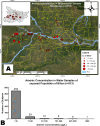
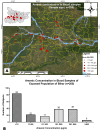
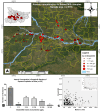
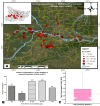

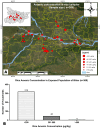

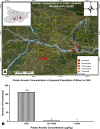

Similar articles
-
Mercury poisoning in women and infants inhabiting the Gangetic plains of Bihar: risk assessment.BMC Public Health. 2025 Apr 4;25(1):1275. doi: 10.1186/s12889-025-22336-9. BMC Public Health. 2025. PMID: 40186162 Free PMC article.
-
High lead contamination in Mother's breastmilk in Bihar (India): Health risk assessment of the feeding children.Chemosphere. 2024 Sep;364:143064. doi: 10.1016/j.chemosphere.2024.143064. Epub 2024 Aug 12. Chemosphere. 2024. PMID: 39142396
-
Assessment of disease burden in the arsenic exposed population of Chapar village of Samastipur district, Bihar, India, and related mitigation initiative.Environ Sci Pollut Res Int. 2022 Apr;29(18):27443-27459. doi: 10.1007/s11356-021-18207-6. Epub 2022 Jan 4. Environ Sci Pollut Res Int. 2022. PMID: 34982385
-
High exposure to inorganic arsenic by food: the need for risk reduction.Arch Toxicol. 2015 Dec;89(12):2219-27. doi: 10.1007/s00204-015-1627-1. Epub 2015 Nov 19. Arch Toxicol. 2015. PMID: 26586021 Review.
-
Arsenic, lead, mercury and cadmium: Toxicity, levels in breast milk and the risks for breastfed infants.Environ Res. 2016 Nov;151:671-688. doi: 10.1016/j.envres.2016.08.027. Epub 2016 Sep 10. Environ Res. 2016. PMID: 27619212 Review.
Cited by
-
How AI can help us beat AMR.NPJ Antimicrob Resist. 2025 Mar 13;3(1):18. doi: 10.1038/s44259-025-00085-4. NPJ Antimicrob Resist. 2025. PMID: 40082590 Free PMC article. Review.
-
Mercury poisoning in women and infants inhabiting the Gangetic plains of Bihar: risk assessment.BMC Public Health. 2025 Apr 4;25(1):1275. doi: 10.1186/s12889-025-22336-9. BMC Public Health. 2025. PMID: 40186162 Free PMC article.
-
Design, synthesis and anti-plant-bacterial (Xoc, Xac, Psa) activity of coumarins derivatives containing amide and sulfonamide moieties.BMC Chem. 2025 Jul 2;19(1):178. doi: 10.1186/s13065-025-01573-4. BMC Chem. 2025. PMID: 40604996 Free PMC article.
References
-
- Mandal BK, Suzuki KT. Arsenic round the world: a review. Talanta. 2002;58(1):201–35. - PubMed
-
- Devi P, Singh P, Kansal SK, editors. Inorganic pollutants in water. Elsevier; 2020.
-
- Rehman MU, Khan R, Khan A, Qamar W, Arafah A, Ahmad A, Ahmad A, Akhter R, Rinklebe J, Ahmad P. Fate of arsenic in living systems: implications for sustainable and safe food chains. J Hazard Mater. 2021;417:126050. 10.1016/j.jhazmat.2021.126050. - PubMed
-
- Hassan MM. Arsenic in groundwater: poisoning and risk assessment. Crc; 2018.
MeSH terms
Substances
Grants and funding
LinkOut - more resources
Full Text Sources
Medical

